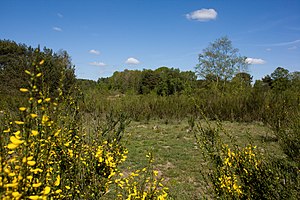Wennebeker Moor and Wennebekniederung
|
Wennebeker Moor and Wennebekniederung
|
||
| location | Schleswig-Holstein , Germany | |
| surface | 1.15 km² | |
| Identifier | 141 | |
| WDPA ID | 166244 | |
| Geographical location | 54 ° 11 ' N , 9 ° 54' E | |
|
|
||
| Setup date | 1988 | |
The Wennebeker Moor and Wennebekniederung is a nature reserve in the Schleswig-Holstein communities of Borgdorf-Seedorf , Eisendorf and Langwedel in the Rendsburg-Eckernförde district .
The 117 hectare nature reserve is entered under number 141 in the directory of nature reserves of the Ministry of Agriculture, Environment and Rural Areas. It was expelled in 1988 (date of regulation: May 19, 1988). The nature reserve is part of the FFH area “Wennebeker Moor und Langwedel”. The responsible lower nature conservation authority is the Rendsburg-Eckernförde district.
The nature reserve is located northeast of Nortorf in the south of the Westensee Nature Park . It includes the Wennebeker Moor, the Wennebek and its lowland with adjacent areas between the federal highway 7 in the north and the state road 49 in the south. The state road 298 leading to Langwedel cuts through the nature reserve. A farm on the state road is excluded from the nature reserve. In the south, part of the Langwedel training area is included in the nature reserve.
The nature reserve is characterized by various landscape elements. In addition to the by wetlands and sedges swamps embossed depression of Wennebek , which occupies the largest part of the protected area, these are dry grasslands and moors to the valley adjacent ridge and the opposite in a basin Wennebeker Moor.
The valley of the Wennebek , which flows a few hundred meters below the nature reserve into the Brahmsee , was traditionally used as grassland . Areas have been taken out of use since they were placed under protection and are now fallow . The marsh marigold still occurs occasionally . Also skullcap , iris , water mint , marsh violets , marsh thistle , pennywort , Avens and Marsh Orchid can be found on the brownfield wet meadows. However, they are often displaced by the swamp sedge. Furthermore, alder and other woody trees grow, so that alder forests gradually emerge.
On higher, dry areas there are overaged and therefore grassy heather areas, other areas are used for agriculture. The heaths were formerly of heather dominated. This only occurs occasionally. Large areas are taken up by willow and partly also by whistle grass . Furthermore falter here u. a. Sandy and downy birches , common oaks , quaking aspen , buckthorn , willow , pine and spruce . Also gorse and bracken are common. Sand bells and silver grass can be found on the remains of dry grass .
Heathland and dry grassland are now grazed with sheep for care, which in particular pushes back the wire smut. Bushes are also slightly contained by browsing.
Between the training area and Weenbek, south of state road 298, there is the 5-hectare Wennebeker Moor, which was drained and dug up in the past. It is now rewetted and is regenerating. The mud sedge has its largest occurrence here in Schleswig-Holstein. Also suitable are various peat moss before and Ordinary and Utricularia minor , Rosebay and Schei Diges cotton grass , Rundblättriger and sundew and crowberry , bell heather and moss berry . The White Schnabelried can also be found here and there. In addition, there are fever clover , clawed moss , chamfer, meadow and stiff sedge as well as reeds , cattails and swamp logs .
The nature reserve offers u. a. Birds , amphibians and reptiles have a habitat. So breed z. E.g. cabbage , blue , fir , bonnet , swamp and willow tit , song and mistletoe , fitis , chiffchaff , robin , wren , brown elk , great spotted woodpecker and wood pigeon in trees and bushes, in the more open areas with rows of trees also tree pipit , Yellowhammer and red-backed shrike . The wasteland offer z. B. Common snipe , reed bunting , field owl and whinchat breeding grounds. The corncrake can also be heard occasionally. The lapwing occasionally breeds on pastures . The moors and reed beds breed reed warbler , water rail , Gray Goose , herons and - teal . Also herons are found here. There is a small breeding colony nearby.
Amphibians and reptiles are by common toad , marsh , grass and water frog , forest lizard , slow worm , grass snake and adder represented.
The nature reserve is looked after by the Schleswig-Holstein State Association of the Nature Conservation Union of Germany . Partial areas belong to the Schleswig-Holstein Nature Conservation Foundation .
Web links
- NABU nature reserve "Wennebeker Moor and Wennebek-Niederung" , Naturschutzbund Germany
- Wennebeker Moor / Wennebekniederung , leaflet of the Nature Conservation Union Germany (PDF; 1.2 MB)
Individual evidence
- ↑ State ordinance on the nature reserve “Wennebeker Moor und Wennebekniederung” of May 19, 1988 , state regulations and state case law, state government Schleswig-Holstein. Retrieved March 21, 2013.
- ↑ Wennebeker Moor and Langwedel , profiles of the Natura 2000 areas, Federal Agency for Nature Conservation . Retrieved March 12, 2020.
- ^ Supervision of protected areas in Schleswig-Holstein , State Office for Agriculture, Environment and Rural Areas , April 2017 (PDF, 275 kB). Retrieved March 12, 2020.



